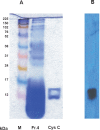Evaluation of cystatin C activities against HIV
- PMID: 26112843
- PMCID: PMC4510722
- DOI: 10.4103/0971-5916.159282
Evaluation of cystatin C activities against HIV
Abstract
Background & objectives: Several host defense proteins known to possess antimicrobial activities are present on mucosal surfaces and are consequently found in body fluids of vertebrates. Naturally occurring protease inhibitors like cystatins, especially cystatin C (cys C), are abundantly present in human seminal plasma. Although its antiviral activity against herpes simplex virus (HSV) has been demonstrated, the role of this protein against HIV is not well studied. Therefore, the aim of the present study was to evaluate the anti-HIV activities of cys C, which is present innately in the male reproductive tract.
Methods: Protein-protein interaction of cys C with various HIV proteins was studied using a commercially available HIV blot and specific interaction with HIV protease was studied by dot-blot technique using commercially available cys C. To purify biologically active cys C from human seminal plasma to be used for subsequent experiments, gel-permeation chromatography followed by affinity chromatography was used. The HIV infectivity inhibition activity of the purified cystatin C was tested in TZM-bl cells. To study its activity on HIV protease, time-course enzyme kinetics studies were performed using spectrometric assay.
Results: Cystatin C reacted with some HIV proteins including HIV protease. Biologically active cys C was purified using gel permeation chromatography followed by affinity chromatography. When tested in TZM-bl cells, purified cystatin C demonstrated HIV-infectivity inhibitory activity (IC 50: 0.28 μM). Enzyme kinetic studies demonstrated that it abrogated the action of HIV protease on its substrate.
Interpretation & conclusions: The present data demonstrate that cystatin C possesses anti-HIV activities. Molecular models need to be designed with this protein which would assist towards prevention/ therapeutics against HIV.
Figures






Similar articles
-
Efficient expression and purification of biologically active human cystatin proteins.Protein Expr Purif. 2016 Feb;118:10-7. doi: 10.1016/j.pep.2015.10.005. Epub 2015 Oct 19. Protein Expr Purif. 2016. PMID: 26481272
-
The role of serpin and cystatin antiproteases in mucosal innate immunity and their defense against HIV.Am J Reprod Immunol. 2014 Jan;71(1):12-23. doi: 10.1111/aji.12166. Epub 2013 Oct 31. Am J Reprod Immunol. 2014. PMID: 24325760 Review.
-
Human salivary cystatin SA exhibits antimicrobial effect against Aggregatibacter actinomycetemcomitans.J Periodontal Res. 2012 Oct;47(5):661-73. doi: 10.1111/j.1600-0765.2012.01481.x. Epub 2012 May 14. J Periodontal Res. 2012. PMID: 22582873
-
The human protease inhibitor cystatin C is an activating cofactor for the streptococcal cysteine protease IdeS.Chem Biol. 2008 Sep 22;15(9):960-8. doi: 10.1016/j.chembiol.2008.07.021. Chem Biol. 2008. PMID: 18804033
-
Diagnostic value of analysis of cystatin C and protein HC in biological fluids.Clin Nephrol. 1992;38 Suppl 1:S20-7. Clin Nephrol. 1992. PMID: 1284235 Review.
Cited by
-
Amyloid-β peptide protects against microbial infection in mouse and worm models of Alzheimer's disease.Sci Transl Med. 2016 May 25;8(340):340ra72. doi: 10.1126/scitranslmed.aaf1059. Sci Transl Med. 2016. PMID: 27225182 Free PMC article.
-
Functional Reciprocity of Amyloids and Antimicrobial Peptides: Rethinking the Role of Supramolecular Assembly in Host Defense, Immune Activation, and Inflammation.Front Immunol. 2020 Jul 31;11:1629. doi: 10.3389/fimmu.2020.01629. eCollection 2020. Front Immunol. 2020. PMID: 32849553 Free PMC article. Review.
-
Identification and molecular profiling of a novel homolog of cystatin C from rock bream (Oplegnathus fasciatus) evidencing its transcriptional sensitivity to pathogen infections.Mol Biol Rep. 2021 May;48(5):4933-4942. doi: 10.1007/s11033-021-06415-9. Epub 2021 May 26. Mol Biol Rep. 2021. PMID: 34041676
-
Cystatin C Falsely Underestimated GFR in a Critically Ill Patient with a New Diagnosis of AIDS.Case Rep Nephrol. 2016;2016:9349280. doi: 10.1155/2016/9349280. Epub 2016 May 17. Case Rep Nephrol. 2016. PMID: 27293926 Free PMC article.
-
Cathepsins and Their Endogenous Inhibitors in Host Defense During Mycobacterium tuberculosis and HIV Infection.Front Immunol. 2021 Aug 4;12:726984. doi: 10.3389/fimmu.2021.726984. eCollection 2021. Front Immunol. 2021. PMID: 34421929 Free PMC article. Review.
References
-
- Shugars DC. Endogenous mucosal antiviral factors in the oral cavity. J Infect Dis. 1999;179(Suppl 3):431–4. - PubMed
-
- Hall SH, Hamil KG, French FS. Host defense proteins of the male reproductive tract. J Androl. 2002;23:585–97. - PubMed
-
- Kopitar-Jerala N. The role of cystatins in cells of the immune system. FEBS Lett. 2006;580:6295–301. - PubMed
Publication types
MeSH terms
Substances
LinkOut - more resources
Full Text Sources
Other Literature Sources
Medical
